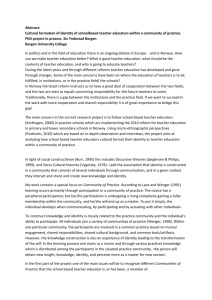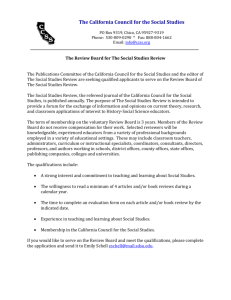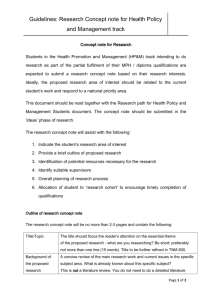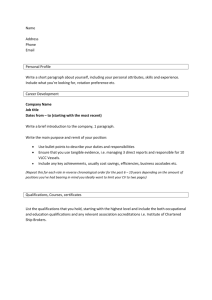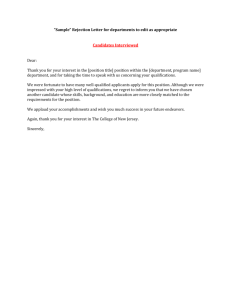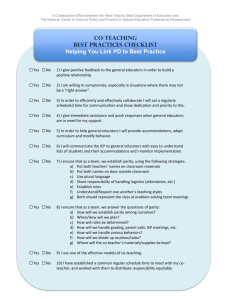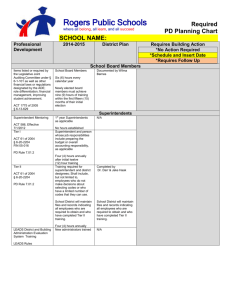TELL15-01-Heather-TELL2015
advertisement
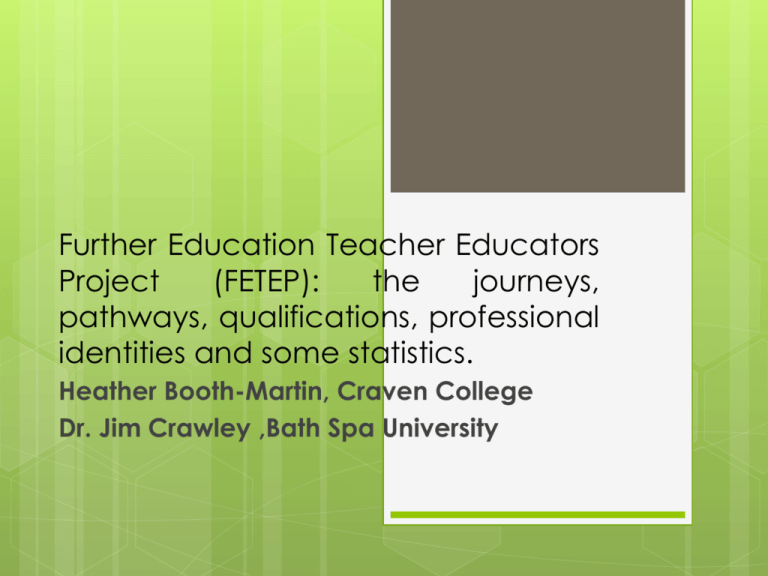
Further Education Teacher Educators Project (FETEP): the journeys, pathways, qualifications, professional identities and some statistics. Heather Booth-Martin, Craven College Dr. Jim Crawley ,Bath Spa University Introduction We are: G. Ade-ojo, H. Booth-Martin, J. Bostock, J. Crawley, B. Eberte, S. Loo (PI), N. Sowe and S. Spencer. The rationale for researching in this area… The aims of this project are: What are the routes to becoming teacher educators/ trainers in the sector? How do teacher educators train others to become teachers? What knowledge(s) do they draw upon and apply in their work? How do they maintain their professional development? How do they view themselves? Visions of the project: inclusive, collaborative and democratic group to build research and publication capacities. Research methodologies The research methodologies include a range of quantitative and qualitative research methods. They are: questionnaires, one-to-one semistructured interviews, documentary research and ‘Talking Heads’. The participants in this project include all the researchers and colleagues in the field. The anticipated sample of the project is 33/34. Part of this methodological approach is the use of ‘buddy researchers’. The methodological ‘safeguards’ include: pilot study, guidelines for researchers as participants, quality control of data capturing and analysis. Some conceptual frameworks Communities of practice, legitimate peripheral participation, and situated learning (Lave and Wenger, 1991) Experiential learning (Kolb, 1984) Modes of recontextualisation (Bernstein, 2000; Barnett, 2006; Evans et al., 2014) Social realist concept of ‘powerful knowledge’ (Young, 2013) Some preliminary findings - I Using the questionnaire survey as a source of data capture only and basing on 23 participants to date (expecting 33/34 in total), here are some of the findings: Gender – F 78% (18), M 22% (5) [F 60% & M 40% – Frontier Economics, 2014]. Working in – HEIs 48% (11), FE 35% (8), PP 13% (3), and Comm. org. 4% (1). Age groups – 50’s 70% (16), 40’s 17% (4) and 30’s 13% (3). Geographical locations – 75% (17) from the UK, 17% (4) the Continent, and 4% (1) from Africa and Asia. Cont.. II Journeys of being teacher educators (currently or previously): Via teaching in FE – 18 participants (overwhelmingly all teacher educators except for 3 participants came via this route) Via HEIs – 11 Via ESOL, EFL and related areas – 6 Via consultancy – 5 (incl. private providers) Via teaching abroad – 4 Via community institutions – 2 Via awarding body or nursery institution – 1 each Cont…III Qualifications (in addition to teaching ones): ESOL, EFL and related qualifications - 7 First degrees: 3 in Education, 2 Art, and the rest one each in Bus/Econ, Drama, English Lit/Lang., History and Archaeology, Hotel and Catering, HRM, Islamic Studies, Journalism, Politics and Zoology. Professional qualification – 1 in Accountancy MAs – 19 in Education-related areas (incl. 1 each in Health Studies, HRM and Polish) PhDs – 3 and EDs – 5 Professional identities: 65% (15) Most definitely; 4% (1) Definitely; 9% (2) Yes; 13% (3) Mixed views; 9% (2) Up to a degree; 0% (0) Certainly not and Most certainly not. There were 7 choices. Future activities Group activities around analysis of the captured data Overview of the data analysis: audit trail and intermethodological triangulations Group activities around dissemination of the findings – conferences and publications And now to you… Thank you for listening to us! We welcome questions on any aspects of the project We look forward to further dissemination of our findings References Barnett, M. 2006. “Vocational knowledge and vocational pedagogy.” In Knowledge, Curriculum and Qualifications for South African Further Education, edited by M. Young and J. Gamble, 143-158. Cape Town: Human Sciences Research Council Press. Bernstein, B. 2000. Pedagogy, Symbolic Control, and Identity. New York: Rowman and Littlefield. Evans, K., D. Guile, J. Harris, and H. Allan. 2010. “Putting knowledge to work: a new approach.” Nurse Education Today 30 (3): 245–251. Frontier Economics Limited. 2014. Further Education workforce data for England: Analysis of the 2012-2013 staff individualized record data. London: Frontier Economics Limited. Kolb, D. 1984. Experiential Learning: experience as the source of learning and development. Englewood Cliffs, NJ: Prentice Hall. Lave, J., & E. Wenger. 1991. Situated Learning: Legitimate Peripheral Participation. Cambridge: Cambridge University Press.
